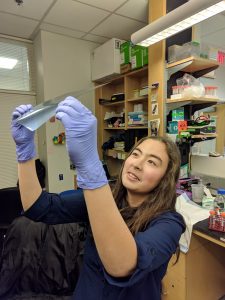At the beginning of the program, I made some goals, and fortunately, I reached those goals. As a refresher, here were my goals I wanted to accomplish:
- I would like to learn to make mistakes.
- I would like to learn to be patient.
- I hope to be able to communicate and learn from the community around me.
The first and second goal go hand-in-hand. I did make some mistakes during the program. I did not use the correct amount of DNA, I made a mistake during a presentation (i.e. mixed up some background information), produced blots where the positive control failed ( I’m not sure what went wrong), and produced blots where the IPs did not show up, when the inputs did (again, I am not sure what went wrong). However, I’ve learned to troubleshoot, and I am continuing to learn to troubleshoot and accept that things do not always work and you have to keep trying. On the same note, cell cultures (especially when starting with single cells) grow very slowly, western blots with IPs takes approximately 4 days, so you need to be patient. If the science does not work, you will have to start again taking even more time, thus, science takes patience and is all about delayed gratification.
The third goal was also achieved. Through BSURF led by Dr. G and Jason, my peers and I were able to listen to amazing talks, give chalk talks, and will give a poster tomorrow. Through my lab, I was able to present what I have accomplished in the summer, and learn from others in my lab. I feel very lucky to have been able to communicate about my science and learn from others as well.
I am really thankful for this experience, and I truly feel that this experience allowed me to see what it is like to do research full time. The BSURF program makes me feel excited about the possibilities of attending graduate school but continues to leave the next step beyond graduate school open. What do I want to do? Do I want to go into industry? Do I want to try to start a startup? Do I want to go into academia? What are my options?
I am excited to continue my work in this lab, to build strong relationships, and to learn more about my next steps.
Thanks for experiencing this program with me!
This was the final blog post.


